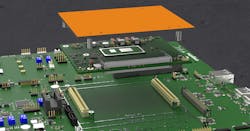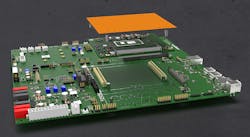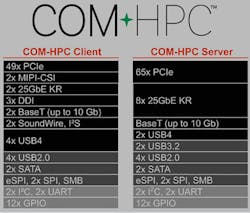COM-HPC: Reaching a Higher (Performance) Standard
COM Express is a PICMG series of standards that define an array of computer-on-module (COM) form factors. Selecting a COM form factor means choosing a set of interfaces exposed on the board’s connectors as well as the amount of space it uses and how it can be cooled. A particular form factor is useful for a range of applications, but not all. Pushing the limits of performance can be a challenge as these standards haven’t always needed to address high-performance-computing (HPC) requirements.
The forthcoming COM-HPC standard is designed to address the high-end space by utilizing PCI Express Gen 4/5 connectors that support 100-Gb Ethernet as well (Fig. 1). The number of pins is also higher than existing COM Express standards to address HPC server applications. Top-end solutions can handle boards that consume more than 200 W of power. The form factor is designed to handle the latest 11th-generation Intel Core processors with up to one terabyte of memory via eight DIMM sockets.
The standard defines a number of board and connector layouts that share common 800-pin connectors, almost double the 440 pins on other COM Express boards. There are two pin-out definitions for COM-HPC Client and Server modules (Fig. 2).
The server provides more 25 Gigabit Ethernet ports and PCI Express lanes. Meanwhile, the client features more peripheral interfaces like four USB 4.0 interfaces and SoundWire, a MIPI standard with two clock and data lines to handle up to four audio codecs. The COM-HPC Client also includes two MIPI-CSI ports and two digital display interfaces (DDIs) that can be used to address video applications. There are common GPIO and serial interfaces.
In general, COM-HPC provides more connectivity between the module and carrier board than the current crop of COM Express board standards. Though the latter can handle applications that need PCI Express Gen 4 as well as high-speed Ethernet, they provide fewer interfaces than the new standard.
The COM-HPC is still being finalized, but vendors are lining up to deliver products already. “With our COM-HPC and COM Express solutions, we offer two very attractive options for the utilization of the latest Intel Tiger Lake processors,” explains Andreas Bergbauer, Product Line Manager at congatec. “We really want to encourage system engineers to test the new COM-HPC platform with all its new features and benefits. This is most easily done as our APIs are 100% identical on COM-HCP and COM Express, which means engineers can work on both platforms and easily switch from one to the other.”
About the Author
William G. Wong
Senior Content Director - Electronic Design and Microwaves & RF
I am Editor of Electronic Design focusing on embedded, software, and systems. As Senior Content Director, I also manage Microwaves & RF and I work with a great team of editors to provide engineers, programmers, developers and technical managers with interesting and useful articles and videos on a regular basis. Check out our free newsletters to see the latest content.
You can send press releases for new products for possible coverage on the website. I am also interested in receiving contributed articles for publishing on our website. Use our template and send to me along with a signed release form.
Check out my blog, AltEmbedded on Electronic Design, as well as his latest articles on this site that are listed below.
You can visit my social media via these links:
- AltEmbedded on Electronic Design
- Bill Wong on Facebook
- @AltEmbedded on Twitter
- Bill Wong on LinkedIn
I earned a Bachelor of Electrical Engineering at the Georgia Institute of Technology and a Masters in Computer Science from Rutgers University. I still do a bit of programming using everything from C and C++ to Rust and Ada/SPARK. I do a bit of PHP programming for Drupal websites. I have posted a few Drupal modules.
I still get a hand on software and electronic hardware. Some of this can be found on our Kit Close-Up video series. You can also see me on many of our TechXchange Talk videos. I am interested in a range of projects from robotics to artificial intelligence.



